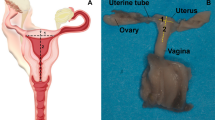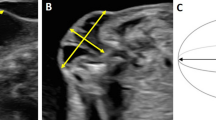Abstract
Caudal regression sequence (CRS) is a rare congenital defect of the lower spinal segments and the neural tube. Motor symptoms as well as neurological deficits and loss of bladder and bowel function are usually present. CRS is also associated with anomalies in other systems such as the gastrointestinal and genitourinary tract. Etiology and pathogenesis are poorly understood.
A newborn presented with anomalies of the spinal column (lumbosacral) with absence/hypoplasia of the 12th thoracic and first lumbar vertebral anomaly body. Bladder and bowel initially were functional. MR-angiography exhibited an anomaly of the unpaired vessels originating from the aorta, a likely relict of a persisting vitelline artery.
These findings indicate a potential vascular genesis of CRS, much as in sirenomelia.
This is a preview of subscription content, access via your institution
Access options
Subscribe to this journal
Receive 12 print issues and online access
$259.00 per year
only $21.58 per issue
Buy this article
- Purchase on Springer Link
- Instant access to full article PDF
Prices may be subject to local taxes which are calculated during checkout


Similar content being viewed by others
References
Valenzano M, Paoletti R, Rossi A, Farini D, Garlaschi G, Fulcheri E . Sirenomelia. Pathological features, antenatal ultrasonographic clues, and a review of current embryogenic theories. Hum Reproduct Update 1999; 5(1): 82–86.
Singh SK, Singh RD, Sharma A . Caudal regression syndrome – case report and review of literature. Pediatr Surg Int 2005; 21(7): 578–581.
Nievelstein RA, Valk J, Smit LM, Vermeij-Keers C . MR of the caudal regression syndrome: embryologic implications. Am J Neuroradiol 1994; 15(6): 1021–1029.
Smith AS, Grable I, Levine D, Case GG . Caudal regression syndrome in the fetus of a diabetic mother. Radiology 2004; 230: 229–233.
Versiani BR, Gilbert-Barness E, Giuliani LR, Peres LC, Pina-Neto JM . Caudal dysplasia sequence: severe phenotype presenting in offspring of patients with gestational and pregestational diabetes. Clin Dysmorphol 2004; 13(1): 1–5.
Padmanabhan R . Retinoic acid-induced caudal regression syndrome in the mouse fetus. Reprod Toxicol 1998; 12(4): 496–498.
Rojansky N, Fasouliotis SJ, Ariel I, Nadjari M . Extreme caudal agenesis. Possible drug-related etiology? J Reprod Med 2002; 47(3): 241–245.
Stevenson RE, Jones KL, Phelan MC, Jones MC, Barr Jr M, Clericuzio C, Harley RA, Benirschke K . Vascular steal: the pathogenetic mechanism producing sirenomelia and associated defects of the viscera and soft tissues. Pediatrics 1986; 78(3): 451–457.
Author information
Authors and Affiliations
Corresponding author
Rights and permissions
About this article
Cite this article
Hentschel, J., Stierkorb, E., Schneider, G. et al. Caudal regression sequence: vascular origin?. J Perinatol 26, 445–447 (2006). https://doi.org/10.1038/sj.jp.7211534
Received:
Revised:
Accepted:
Published:
Issue Date:
DOI: https://doi.org/10.1038/sj.jp.7211534



